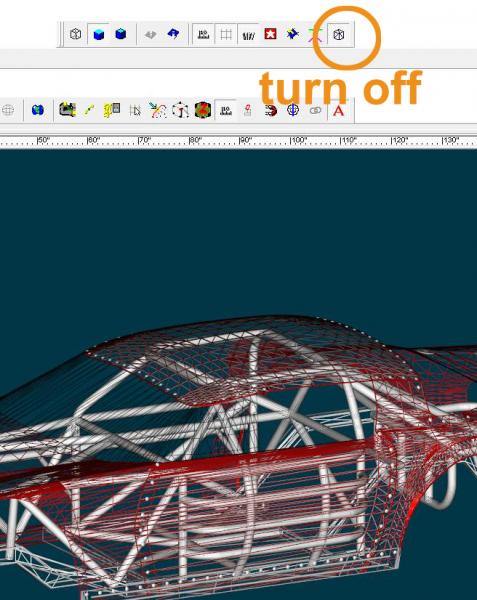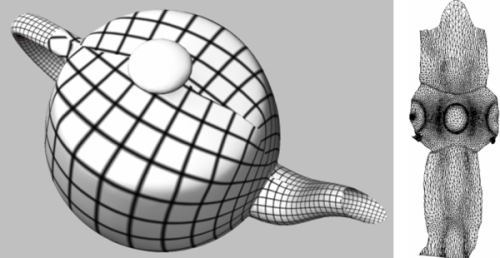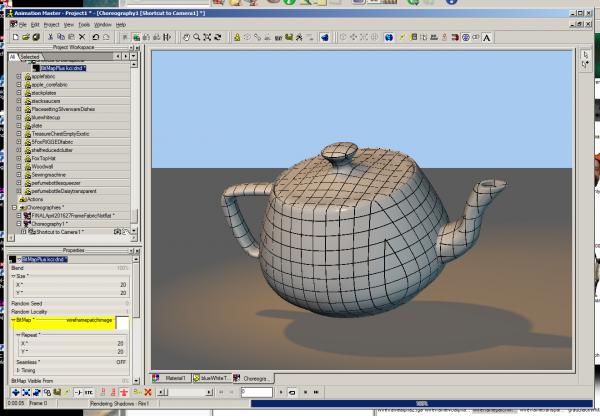-
Posts
7,863 -
Joined
-
Last visited
-
Days Won
15
Content Type
Profiles
Forums
Events
Posts posted by NancyGormezano
-
-
very interesting!
-
Father Bear was reading the Kinsey Report. In bed!
Looks like it had a happy ending.
(Did I just say that?)
-
I did not enter mascot contest but here is mine not done lol
just messing around
Put some eyeballs in those headlights and you've got a mascot entry
-
VERY interesting! Great find. How can it be FREE???
They are in the business of selling content - YOUR content
-
For those that are interested - here is a nice description of Eulers, quats (and perhaps may give insight into Hash Vector implementation). I have not used vector interpolation in A:M.
As the article points out, and as I have always known and believed is that gimbal lock is more a problem with using Eulers, rather than quats. This is why we used quaternions, when I was working for Link Flight Simulators (for navigation as well as image generation).
However that is not to say that A:M's specific implementation might have a problem with quats and gimbal lock. Not sure why they would. It may be the internal setup of interpolation method?
http://www.chrobotics.com/library/understanding-quaternions
(I have not checked the accuracy of the above article)
-
-
Those look awesome.
Ever see Akvis airbrush? Wonder how it would look if applied to an animation?
Thanks - Interesting find
I wasn't aware of Akvis - but it looks like it possibly could be used with animation as it has a batch processing mode on a sequence of images - so could potentially bring the modified images into AfterEffects or any other video editor - great!
The software offer Batch Processing feature that lets you automatically process a series of images. It is useful when dealing with a lot of photos or when creating a video (to process all frames automatically).
AKVIS AirBrush is available as a standalone application and as a plugin filter. The plugin version is compatible with Adobe Photoshop, Photoshop Elements, Corel PaintShop Pro, and other photo editors. Consult the AKVIS plugins compatibility page.
The functionality of the product depends on the license type. During the trial period you can try all options and choose the license you like.
I have AE cs4, PS cs4 and Painter 13 - none of which, seems to be compatible - BUT it does have a stand alone mode - so no problemo!
However, problem with filters (any filter, procedural processing) is that it is usually very obvious that a filter has been used, so it's up to user to cook up some combo of filters to disguise the fact and make resultant image look unique, hand worked.
I am finding that most illustrators, publishers, art directors turn up their nose at filters, because it is instantly recognizable.
Worth a look anyway. Thanks
-
He had it set up with a "Dome" stamped. The trick is getting the settings on the HDRI IMAGE correct if I remember right.
You must choose the light type choice. Sphere, Box, Coordinate.....I think there are 3 choices.
In A:M/ chor:
One uses Global Ambiance type = Image based lighting, with an environment map (any ol' image you want to use, HDRI or otherwise) and a mapping type: latitude-longitude, light probe, mirror sphere, cube map (cross). Depends on how/what the image is that you are using has been created. I usually select lat-long and use any image that has the right coloring that I like. But I don't go for physically based lighting. light probe images, mirror sphere images are usually physically based.
Regardless of image being used for IBL, environment map (no dome):
You set the Ambiance Intensity % (optionally also can set exposure, azimuth, I never do)
and can optionally use Ambiance Occlusion (or fakeao or ssao). If you want to use A:M native Ambiance Occlusion, then yes, you must set chor/camera/render options/Ambiance Occlusion = ON. For just Image based lighting IBL (no occlusion) - it can be OFF, and Ambiance occlusion =0% in chor.
It's not that hard. Very easy.
Not necessary to make separate renders for characters and background. You can use whatever background (camera roto, or dome with image mapped to dome) you want in A:M. The image used for background can be different from image used for environment lighting (IBL). If you want to use different background (can't decide) and composite later, then yes, make 2 renders - character and background.
-
I just tried 18p - works the same as 17g - must toggle AO percent (or type of Global ambiance) for new image to take effect.
tried with opengl3
-
Answering my own question... again. Looks like IBL utilizes A:M's proprietary AO... so that needs to be activated ON in the render settings... NICE!
what version? If you just want to use IBL in 17g - you don't need to use AO as well - does not need to be ON in render settings.
However, there does seem to be a glitch, in changing images to use for IBL, and doing quick screen renders (and maybe final renders) for testing. This glitch/bug has been there forever.
What I do when wanting to experiment with different images: I toggle the % in AO setting (change to 1) and then put it back to 0% - then the new image will take effect.
-
"The nagging upgrade prompts will stop after July 29, 2016, when Windows 10 ceases to be a free upgrade for Windows 7 users."
I am counting the days. That's when I'll be free. yes siree!
Uh...Not so fast, little lady. Somehow, I think the annoying upgrade prompts will just change to "windows 10 - get it now for $xxx.xx"
sigh.
-
Any preferencesasto which version or any other critical feedback very welcome
I prefer version F where background is more obvious.
But in either version, I find the flickering of the character on the right very distracting. I don't understand why one character is hand drawn and the other isn't. Is there a reason?
Perhaps both characters should be hand drawn and flickering so attention of viewer isn't diverted.
The choppiness of the animation is an issue also.
Semi-realistic CG rendering and animation of humans is less forgiving than doing a stylized version of human. We viewers require less perfection of the animation style when the characters are stylized. We will accept the choppy and flickering easier.
-
Get out of the way peasants, we will crush you with our square wheel covers.
-
I remember back in vers 7.1- 8.5 days that A:M had the ability to change the icon on an individual basis for the model files for sure (windows 95? 98? etc)
It was great and was sorry to see it go. Could get an idea of what each model looked like just by listing the content of folders outside of A:M. The ico image used was the same image that was generated with "make icon" feature in A:M (if I recall correctly).
I also remember there was a feature to create a "clippy" bot type animation character agent - forget what those are called - the standard one that came with A:M was the merlin guy. But those didn't go over too well, as most people want to hide those annoying creatures when working.
-
very interesting!
-
mac pro, quad core, nvidia Geoforce
he doesn't make any mention of what kind of nvidia geforce...
-
Also, I noticed that when building a model from scratch, A:M keeps creating these 'rotoscope' files that are essentially non-files. THe actual rotoscope files still exist but these empty ones keep getting automatically created for some unknown reason.
Hmmm...that phantom rotoscope problem was a bug in A:M long ago that got fixed. It also happened on PC side. Those roto items actually showed up in materials, models, chors, etc and you had to delete them manually (text editor).
What version of A:M are you using?
If you are using recent version of A:M then submit a bug report, with simple case.
I have found in newer versions of A:M that if you delete all those phantom rotoscope items (in materials, models, etc probably created in older versions) from the PWS and then save your materials, models, chors, etc in newer version then the problem goes away, not to be seen again.
It use to be that if you save anything while the rotoscope ickies are showing in the PWS, then the contamination of all files just keeps getting worse (ie more and more dum dum roto references).
-
ok - this looks promising - have you tried it? And what's the catch? ie why is it free?
-
-
Some filename extensions—such as MOV, AVI, MXF, and FLV—denote container file formats rather than denoting a specific audio, video, or image data format. Container files can contain data encoded using various compression and encoding schemes. Adobe Media Encoder can import these container files, but the ability to import the data that they contain is dependent on which codecs (specifically, decoders) are installed.
By installing additional codecs, you can extend the ability of Adobe Media Encoder to import additional file types. Many codecs must be installed into the operating system and work as a component inside the QuickTime or Video for Windows formats. Contact the manufacturer of your hardware or software for more information about codecs that work with the files that your specific devices or applications create.
and on same page
QuickTime movie (MOV; on Windows, requires QuickTime player)perhaps page has not been updated?
I guess the more important question for me is: 1) is there an encoder/player available from anyone (other than Quicktime) that can play different formats as well as assemble into some format from image sequences (generated by A:M) that can STEP thru on a frame by frame basis like the Quicktime player currently does ? and 2) does the adobe media player do it? ie step thru frame by frame and 3) is Adobe media player available for those who do not subscribe to CC?
-
I think? Robert is asking for the assumed extension that comes up first when one saves a video file from the adobe media encoder (file format): - eg Save as Type? In quicktime, it is "save as type: movies" that video file gets a .mov extension. We associate .mov files with quicktime.
And yes, as well, you can EXPORT many different types from quicktime: ie avi, m4v, flc, .3gp, .mp4, etc etc. And each file format has different codecs/video format settings that they use for compressing the file eg for mp4 file type you can choose mpeg-4 improved, basic, H.264. For .mov file type you can choose H.264, DV pal, jpeg 2000, etc etc
Can adobe media encoder export or save files to file type .mov?
-
The link to the latest Squetch Rig in my signature should point to the latest version...that's where it goes when I test it.
yes it does go to the latest - I think Marcos is suggesting that the date is incorrect - your signature says Squetch Rig was last updated 5/20/2015
-
Perhaps this was generated via 3D fractal generating software Mandelbulber
-
An awesome plugin for AM would be LSCM (least squares conformal mapping) for UV mapping. Been asking for this for ages.
okie-dokie I'll bite:
what is this? Can you show a sorta maybe example-ish image
okay I found an explanation by googling (other mapping algorithms also included). Taken from link:
"The Least Squares Conformal Maps (LSCM) parameterization method has been introduced by Lévy et al. [7]. It corresponds to a conformal method with a free border (at least two vertices have to be constrained to obtain a unique solution), which allows further lowering of the angle distortion. A one-to-one mapping is not guaranteed by this method. It solves a (2 × #triangles) × #vertices sparse linear system in the least squares sense, which implies solving a symmetric matrix"
http://doc.cgal.org/latest/Surface_mesh_parameterization/index.html
images and CODE at link above.
This type of mapping sorta, almost, not quite looks similar to the mapping done by the BitMapPlus kci:dnd Plug-in. Perhaps a place to start?





Animations/short films - common mistakes
in Off Topic
Posted
15 things wrong with your short film
Interesting article